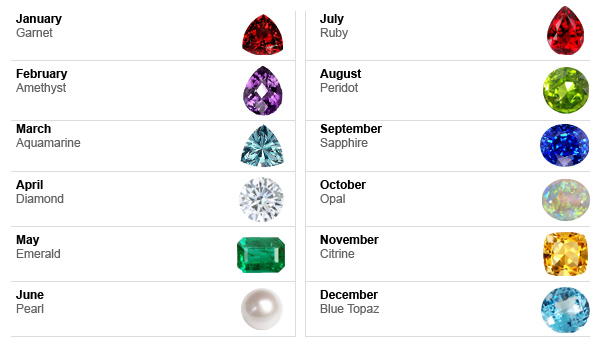Birthstone Information
The origin of birthstones is believed to date back to the breastplate of Aaron which contained twelve gemstones representing the twelve tribes of Israel.
January: The gemstone for January is the Red Garnet.
The Red Garnet is named as the Birth Stone representing January in Polish, Arabic, Hebrew, Roman and Russian traditions.
In ancient Hindu tradition, the stone for January is known as the ‘serpent stone’. This was said to be either a Ruby or black stone. According to Indian astrology, garnet helps eliminate negative feelings (depression, guilt) and instill greater self-confidence and mental clarity to promote creative thinking and peace of mind.
February: The symbolic stone of February is the Amethyst. Amethyst is the gem traditionally given for the sixth wedding anniversary.
The name comes from the Ancient Greek, derived from the word “methustos,” which means “intoxicated.”
In ancient Hindu tradition, the stone for February was the ‘chandrakankta’ which is a stone that no one today has ever seen.
March: The Aquamarine is the crystal for the month of March in many traditions and cultures. Aquamarine is not only the birthstone for March, but the gem is also given as a present on the 19th wedding anniversary.
The Roman, Arabic, Polish, Hebrew and Russian traditions name the stone for March as the Bloodstone.
In ancient Hindu tradition the stone for March was called ‘gold-sivalinga’, which is not a stone seen today.
April: The Diamond is the birth stone for the month of April. Diamond is the gift of choice for the 60th and 75th wedding anniversaries.
The name for Diamond comes from the Greek word "adamas," which means “invincible” or “unbreakable.”
The first diamond engagement ring on record was given by Archduke Maximillian of Austria to his betrothed, Mary of Burgundy, in 1477.
May: The stone symbolizing the month of May is Emerald according the modern North American tradition. It's the gemstone given for the 20th and 35th wedding anniversaries.
Ancient Hindu tradition also sees the Emerald as the stone for May, whilst Hebrew and Roman traditions name Agate as the stone for May. The name Emerald comes from the Greek ‘smargados’ simply meaning green stone.
June: Many stones represent and symbolize the month of June, including the Moonstone, Pearl and Alexandrite.
Ancient Hebrew traditions claim the Pearl to be the birth stone for June, whilst in ancient Roman and Hebrew traditions the Emerald was named. Agate is said to rule the month of June in Polish Russian and Arabic cultures.
July: The stone representing the month of July, according to modern North American, Polish and Russian cultures, is the Ruby.
Roman and Hebrew traditions name the Onyx as the stone for July, whereas in Arabic culture the Carnelian is attributed to July. In Hindu tradition the stone for July is the Sapphire.
August: The month of August has many different stones associated with it. Modern North American tradition sees the Peridot as the stone for August.
Roman and Hebrew traditions attribute the Carnelian to the month of August, and Polish and Arabic traditions name the Sardonyx as the stone representing August. In Hindu tradition the Ruby is the stone associated with August, while Russian tradition assigns it to the Alexandrite.
September: September is said to be ruled by the Sapphire in modern North American traditions.
In Roman, Hebrew, Polish, Russian and Arabic traditions the Peridot is stated as the stone for September. In Hindu traditions the stone representing September is the Zircon.
October: The month of October is represented by the Opal and Tourmaline.
However Hebrew, Arabic, Polish and Roman traditions state that Aquamarine is the symbolic stone. In Russian tradition the stone attributed to October is Beryl. Ancient Hindu traditions name Coral as the stone representing the month of October.
November: The month of November is represented by Yellow Topaz and Citrine as its stones in modern North American culture.
The Roman, Hebrew, Arabic and Russian traditions attribute Topaz to November, and in Hindu traditions November is symbolized by the Cat’s Eye.
December: The month of December has various stones attributed to it. Modern North American tradition assigns a choice of the blue stones Tanzanite, Turquoise and Blue Topaz.
Russian and Polish tradition state that the stone for December is Turquoise. The Roman, Arabic and Hebrew traditions name the Ruby as the stone for December. In Hindu tradition, Topaz is the stone symbolizing the month of December.
